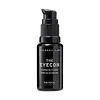What's inside
What's inside
 Key Ingredients
Key Ingredients

 Benefits
Benefits

 Concerns
Concerns

 Ingredients Side-by-side
Ingredients Side-by-side

Aloe Barbadensis Leaf Juice
Skin ConditioningHelianthus Annuus Seed Oil
EmollientCetearyl Alcohol
EmollientCaprylic/Capric Triglyceride
MaskingGlycerin
HumectantBetaine
HumectantPopulus Tremuloides Bark Extract
AntiseborrhoeicCetearyl Wheat Straw Glycosides
EmulsifyingWater
Skin ConditioningAlcohol
AntimicrobialAlthaea Officinalis Leaf/Root Extract
EmollientBorago Officinalis Seed Extract
Skin ConditioningButylene Glycol
HumectantCarbomer
Emulsion StabilisingCetearyl Glucoside
EmulsifyingCrithmum Maritimum Extract
Skin ConditioningDiglycerin
HumectantDisodium EDTA
Hexapeptide-11
Skin ConditioningPalmitoyl Tetrapeptide-7
Skin ConditioningPalmitoyl Tripeptide-1
Skin ConditioningP-Anisic Acid
MaskingPinus Pinaster Bark/Bud Extract
AntimicrobialPolysorbate 20
EmulsifyingPortulaca Oleracea Extract
Skin ConditioningPropylene Glycol
HumectantRhodiola Rosea Root Extract
EmollientRosmarinus Officinalis Leaf Extract
AntimicrobialSodium Hyaluronate
HumectantSodium Lactate
BufferingTetrasodium EDTA
Tocopherol
AntioxidantXanthan Gum
EmulsifyingMethylparaben
PreservativePotassium Sorbate
PreservativePropylparaben
PreservativeSodium Benzoate
MaskingAloe Barbadensis Leaf Juice, Helianthus Annuus Seed Oil, Cetearyl Alcohol, Caprylic/Capric Triglyceride, Glycerin, Betaine, Populus Tremuloides Bark Extract, Cetearyl Wheat Straw Glycosides, Water, Alcohol, Althaea Officinalis Leaf/Root Extract, Borago Officinalis Seed Extract, Butylene Glycol, Carbomer, Cetearyl Glucoside, Crithmum Maritimum Extract, Diglycerin, Disodium EDTA, Hexapeptide-11, Palmitoyl Tetrapeptide-7, Palmitoyl Tripeptide-1, P-Anisic Acid, Pinus Pinaster Bark/Bud Extract, Polysorbate 20, Portulaca Oleracea Extract, Propylene Glycol, Rhodiola Rosea Root Extract, Rosmarinus Officinalis Leaf Extract, Sodium Hyaluronate, Sodium Lactate, Tetrasodium EDTA, Tocopherol, Xanthan Gum, Methylparaben, Potassium Sorbate, Propylparaben, Sodium Benzoate
Aloe Barbadensis Leaf Juice
Skin ConditioningHelianthus Annuus Seed Oil
EmollientPrunus Armeniaca Kernel Oil
MaskingCetearyl Alcohol
EmollientCetearyl Glucoside
EmulsifyingBetaine
HumectantSaccharomyces Cerevisiae Extract
Skin ConditioningRhodiola Rosea Root Extract
EmollientGlycerin
HumectantCaprylic/Capric Triglyceride
MaskingAmaranthus Caudatus Seed Extract
Skin ConditioningCamellia Oleifera Seed Oil
Skin ConditioningCaprylyl Glyceryl Ether
CleansingCaprylhydroxamic Acid
Propanediol
SolventPopulus Tremuloides Bark Extract
AntiseborrhoeicRubus Idaeus Seed Extract
Skin ConditioningSolanum Tuberosum Starch
AbsorbentFurcellaria Lumbricalis Extract
Skin ConditioningBentonite
AbsorbentHexapeptide-11
Skin ConditioningDipalmitoyl Hydroxyproline
Skin ConditioningEpilobium Angustifolium Flower/Leaf/Stem Extract
Skin ConditioningOleic Acid
EmollientTerminalia Arjuna Extract
Skin ConditioningLecithin
EmollientGlycine Soja Oil
EmollientPolyglyceryl-3 Diisostearate
EmulsifyingOryza Sativa Extract
AbsorbentOryza Sativa Germ Extract
EmollientBuddleja Davidii Meristem Cell Culture
Skin ConditioningEchinacea Angustifolia Meristem Cell Culture
Skin ConditioningCetyl Palmitate
EmollientMalus Domestica Fruit Cell Culture Extract
Skin ConditioningSodium Hyaluronate
HumectantRosmarinus Officinalis Leaf Extract
AntimicrobialSodium Phytate
Opuntia Ficus-Indica Seed Oil
EmollientXanthan Gum
EmulsifyingAloe Barbadensis Leaf Juice, Helianthus Annuus Seed Oil, Prunus Armeniaca Kernel Oil, Cetearyl Alcohol, Cetearyl Glucoside, Betaine, Saccharomyces Cerevisiae Extract, Rhodiola Rosea Root Extract, Glycerin, Caprylic/Capric Triglyceride, Amaranthus Caudatus Seed Extract, Camellia Oleifera Seed Oil, Caprylyl Glyceryl Ether, Caprylhydroxamic Acid, Propanediol, Populus Tremuloides Bark Extract, Rubus Idaeus Seed Extract, Solanum Tuberosum Starch, Furcellaria Lumbricalis Extract, Bentonite, Hexapeptide-11, Dipalmitoyl Hydroxyproline, Epilobium Angustifolium Flower/Leaf/Stem Extract, Oleic Acid, Terminalia Arjuna Extract, Lecithin, Glycine Soja Oil, Polyglyceryl-3 Diisostearate, Oryza Sativa Extract, Oryza Sativa Germ Extract, Buddleja Davidii Meristem Cell Culture, Echinacea Angustifolia Meristem Cell Culture, Cetyl Palmitate, Malus Domestica Fruit Cell Culture Extract, Sodium Hyaluronate, Rosmarinus Officinalis Leaf Extract, Sodium Phytate, Opuntia Ficus-Indica Seed Oil, Xanthan Gum
Ingredients Explained
These ingredients are found in both products.
Ingredients higher up in an ingredient list are typically present in a larger amount.
Aloe Barbadensis Leaf Juice comes from leaves of the aloe plant. Aloe Barbadensis Leaf Juice is best known for helping to soothe sunburns. It is also anti-inflammatory, moisturizing, antiseptic, and can help heal wounds.
Aloe is packed with good stuff including Vitamins A, C, and E. These vitamins are antioxidants, which help fight free-radicals and the damage they may cause. Free-radicals are molecules that may damage your skin cells, such as pollution.
Aloe Barbadensis Leaf Juice also contains sugars. These sugars come in the form of monosaccharides and polysaccharides, folic acid, and choline. These sugars are able to help bind moisture to skin.
It also contains minerals such as calcium, 12 anthraquinones, fatty acids, amino acids, and Vitamin B12.
Learn more about Aloe Barbadensis Leaf JuiceBetaine is a common humectant (a substance that promotes retention of moisture). It's known to be gentle on the skin and can help balance hydration.
This ingredient is best for improving hydration and soothing irritated skin. Studies also show it helps even out skin tone.
Fun fact: Betaine is naturally created in the skin and body. The kind found within cosmetic products can be either plant-derived or synthetic.
Another name for betaine is trimethylglycine.
Learn more about BetaineThis ingredient is an emollient, solvent, and texture enhancer. It is considered a skin-softener by helping the skin prevent moisture loss.
It helps thicken a product's formula and makes it easier to spread by dissolving clumping compounds.
Caprylic Triglyceride is made by combining glycerin with coconut oil, forming a clear liquid.
While there is an assumption Caprylic Triglyceride can clog pores due to it being derived from coconut oil, there is no research supporting this.
Learn more about Caprylic/Capric TriglycerideCetearyl alcohol is a mixture of two fatty alcohols: cetyl alcohol and stearyl alcohol. It is mainly used as an emulsifier. Emulsifiers help prevent the separation of oils and products. Due to its composition, it can also be used to thicken a product or help create foam.
Cetearyl alcohol is an emollient. Emollients help soothe and hydrate the skin by trapping moisture.
Studies show Cetearyl alcohol is non-toxic and non-irritating. The FDA allows products labeled "alcohol-free" to have fatty alcohols.
This ingredient is usually derived from plant oils such as palm, vegetable, or coconut oils. There is debate on whether this ingredient will cause acne.
Due to the fatty acid base, this ingredient may not be Malassezia folliculitis safe.
Learn more about Cetearyl AlcoholCetearyl Glucoside is a surfactant and emulsifier. It can be produced from synthetic of natural sources of cetearyl alcohol and glucose.
Emulsifiers help prevent ingredients from separating, such as oils and waters. It can also be used to enhance the texture of products.
As a surfactant, Cetearyl Glucoside helps during the cleansing process. By gathering all the dirt and oils, it allows these molecules to be washed away easily.
Learn more about Cetearyl GlucosideGlycerin is already naturally found in your skin. It helps moisturize and protect your skin.
A study from 2016 found glycerin to be more effective as a humectant than AHAs and hyaluronic acid.
As a humectant, it helps the skin stay hydrated by pulling moisture to your skin. The low molecular weight of glycerin allows it to pull moisture into the deeper layers of your skin.
Hydrated skin improves your skin barrier; Your skin barrier helps protect against irritants and bacteria.
Glycerin has also been found to have antimicrobial and antiviral properties. Due to these properties, glycerin is often used in wound and burn treatments.
In cosmetics, glycerin is usually derived from plants such as soybean or palm. However, it can also be sourced from animals, such as tallow or animal fat.
This ingredient is organic, colorless, odorless, and non-toxic.
Glycerin is the name for this ingredient in American English. British English uses Glycerol/Glycerine.
Learn more about GlycerinHelianthus Annuus Seed Oil is the oil derived from the seeds of a Sunflower. Sunflower seed oil is non-fragrant. It is an emollient, meaning it helps to soften the skin.
Sunflower seed oil contains many fatty acids. The fatty acids found in sunflower seeds include (from highest amount to least): linoleic acid, myristic acid, palmitic acid, stearic acid, arachidic acid, oleic acid, and linolenic acid.
These fatty acids help the skin create ceramides. Ceramides play a role in repairing the skin barrier.
Helianthus Annuus Seed Oil helps moisturize the skin. This in turn helps the skin look more rejuvenated and smoother.
Sunflowers are rich in vitamin E.
Historians believe Indigenous cultures of North America domesticated sunflowers before corn. Thus they relied on sunflower oil for a variety of uses. One such use is moisturizing skin and hair.
Sunflower seed oil may not be fungal acne safe. We recommend speaking with a professional if you have any concerns.
Learn more about Helianthus Annuus Seed OilThis synthetic peptide is known as a signal peptide. Signal peptides tell your skin to create more collagen, elastin and protein.
Hexapeptide-11 is composed of several amino acids, including alanine.
We don't have a description for Populus Tremuloides Bark Extract yet.
We don't have a description for Rhodiola Rosea Root Extract yet.
Rosmarinus Officinalis Leaf Extract comes from rosemary. Rosemary is native to the Mediterranean.
While Rosmarinus Officinalis Leaf Oil can be volatile due to its fragrant properties, the fragrance components are usually removed in the leaf extract.
Rosemary Leaf Extract contains many antioxidants such as rosmarinic acid and caffeic acid. Rosemarinic acid, a compound found in rosemary leaf, has been found to help soothe skin conditions such as eczema and acne.
Learn more about Rosmarinus Officinalis Leaf ExtractSodium Hyaluronate is hyaluronic acid's salt form. It is commonly derived from the sodium salt of hyaluronic acid.
Like hyaluronic acid, it is great at holding water and acts as a humectant. This makes it a great skin hydrating ingredient.
Sodium Hyaluronate is naturally occurring in our bodies and is mostly found in eye fluid and joints.
These are some other common types of Hyaluronic Acid:
Learn more about Sodium HyaluronateXanthan gum is used as a stabilizer and thickener within cosmetic products. It helps give products a sticky, thick feeling - preventing them from being too runny.
On the technical side of things, xanthan gum is a polysaccharide - a combination consisting of multiple sugar molecules bonded together.
Xanthan gum is a pretty common and great ingredient. It is a natural, non-toxic, non-irritating ingredient that is also commonly used in food products.
Learn more about Xanthan Gum